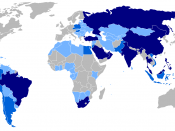In the 1970's European countries were lending money because the economic growth was good especially as the exports from LDCs were large. These loans were in dollars of floating rates of interest, which left the LDCs in a vulnerable state of risking any sudden rise in interest rates. In 1979-80 as the oil prices shot up from $13 per barrel to $32 per barrel the United States decided to use measures of squeeze out inflation. The economies were deflated by pushing interest rates up to 20%, which caused a world wide recession. The recession led to the interest rates of borrower countries' loans to go up and affected LDCs as lower prices for their exporting resulted in a fall in their export earnings. They now have to pay back more than they borrowed to repay their debt. Banks did not want to lend to the LDCs any longer, but preferring to lend to the United States and the high interest rate led to an increase in the real value to LDCs debt service repayment.
The collapsing commodity prices may seem like an advantage to the developed countries, but the failure to produce buying power and markets in the LDCs, the loss of buying power in both the developing and developed countries lowering both wages and prices that will eventually collapse the developed countries values. Many textbooks of diplomacy will say to pay no attention to the various excuses given to explain these wars. They state that the reasons are "national security"ÃÂ when the truth is really "grand strategy"ÃÂ to gain control of resources and markets and the wealth that monopolization makes. These are large battles over who controls the production and trade, thus who controls the wealth produced and traded. These banks have lent over a trillion dollars all over the world without any development plans. Only the public financial institutions should give loans to LDCs, since they can hope to impose controls on use of funds and management on economies necessary to make sure that loans are made in conditions of maximizing the chances of repayment.
Altering the structure and nature of the debt led the banks to argue that by prolonging the period of repayment, the debt service repayment would become much more manageable. This strategy was used since 1982 because the crisis was looked at as a temporary problem. This includes debt equity swaps. For example, when a commercial bank sells some of its debt at a discount to a third party who buys the debt. There is also a debt-debt swap which involves a bank to exchange the debt for bonds that are issued at a discount. The second type of strategy is the Economic reform in borrowing countries, This involves the World Bank and The International monetary Fund structural adjustment programs that aim to improve the ability of debtor nations to service their debts. The reforms include the economies becoming competitive by devaluation, the fiscal policy of reducing government expenditures, and tight monetary policy so inflation will be stabilized. The reason to all this was to reduce imports and expand exports as a way to improve a country's current debt repayments. However it often resulted in an increase of unemployment and an increase in the prices of basic commodities like food. The third proposal was debt forgiveness. This was happening because banks realized that they were to get loans they have made and that without the debt relief the debtors will default, but most banks are reluctant to even consider debt forgiveness because of the cost.





